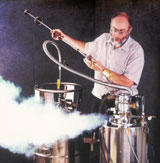NIST Research Reveals Tiny Iron Supplement Has 'Chilling' Effect That Bodes Well for Magnetic Refrigeration

A pinch of iron dramatically boosts the cooling performance of a material considered key to the development of magnetic refrigerators, report researchers at the Commerce Department's National Institute of Standards and Technology (NIST) in tomorrow's issue of Nature. The achievement might move the promising technology closer to market, opening the way to substantial energy and cost savings for homes and businesses.
By adding a small amount of iron (about 1 percent by volume), the NIST team enhanced the effective cooling capacity of the so-called "giant magnetocaloric effect" material by 15 to 30 percent. The result, writes materials scientist Virgil Provenzano and his NIST colleagues, "is a much-improved magnetic refrigerant for near-room-temperature applications."
The original material—a gadolinium-germanium-silicon alloy—already is considered an attractive candidate for a room-temperature magnetic refrigerant. However, its cooling potential is undercut by significant energy costs exacted during the on-and-off cycling of an applied magnetic field, the process that drives the refrigeration device. These costs—called hysteresis losses—translate into commensurate losses of energy available for cooling.
Hysteresis, which results in magnetized remnants that persist after an applied magnetic field is relaxed, can be technologically useful. For example, it enables bits of data to be stored on magnetic disks and tapes. In the case of the gadolinium-germanium-silicon alloy, however, it penalizes cooling performance.
The iron supplement overcomes this disadvantage. It nearly eliminates hysteresis and the associated energy cost, permitting the material to perform near the peak of its potential.
Independently suggested by two scientists in the 1920s, earning one the Nobel Prize in 1949, magnetic refrigerators offer sizable prospective advantages over the century-old technology of today's vapor-compression cooling systems. Potential pluses include substantial gains in energy efficiency, lower cost of operation, elimination of environmentally damaging coolants, and nearly noise- and vibration-free operation.
With recent progress in materials science and engineering, magnetic refrigeration technology is edging into contention for specialized uses, such as cooling sensors in spacecraft and liquefying gases. Further advances, like the one reported by the NIST team, are necessary if the technology is to replace household refrigerators, freezers, dehumidifiers and air conditioners, which account for about 25 percent of residential energy usage.
When exposed to a magnetic field, the gadolinium alloy and other magnetocaloric-effect materials heat up as their spinning electrons align with the field, thereby magnetizing the materials and raising their temperature. When the external field is removed, the materials demagnetize—the electrons revert to a disordered magnetic-spin state—and their temperature drops. The two-stage process forms the magnetic refrigeration cycle.
In the case of the iron-free gadolinium alloy, however, the electrons become disorganized at field strengths different from those required to align them. Consequently, energy is required to cycle the field, diminishing the material's effective capacity for cooling.
Adding the iron supplement largely suppresses a rearrangement of atoms that occurs as the applied magnetic field increases (or temperature decreases) in the original gadolinium alloy. In turn, stifling the shift in atomic structure all but eliminates the hysteresis loss, the NIST team found. This substantially increased the efficiency of the refrigerant by reducing the energy cost corresponding to the application, and then, removal of a magnetic field.
As important, the iron broadened the range of temperatures over which the material achieves acceptable cooling performance, peaking at 32 degrees Celsius (89 degrees Fahrenheit), compared with 0 degrees Celsius (32 degrees Fahrenheit) for the iron-free alloy.
NIST magnetics researcher Robert Shull, one of the NIST inventors of the new nanocomposite material, notes that the modest addition of iron results in the formation of nanometer-sized magnetic clusters in the gadolinium alloy. In earlier research, Shull and his colleagues demonstrated that dispersing what are essentially tiny magnets throughout a material can greatly enhance the size of the temperature increase resulting from the application of an external magnetic field.
"How such a nano-magnetic structure developed is unknown," Shull explains. "It's existence is certain, but its cause is very subtle."
As a non-regulatory agency of the U.S. Department of Commerce's Technology Administration, NIST develops and romotes measurement, standards and technology to enhance productivity, facilitate trade and improve the quality of life.

